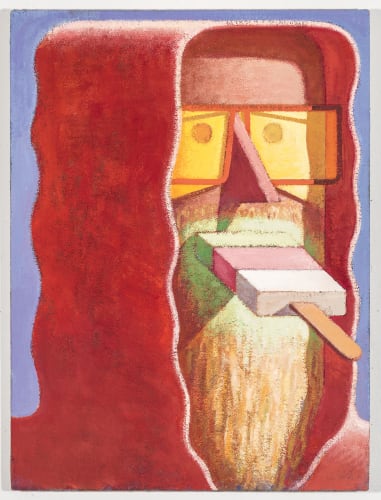Kathryn Markel Fine Arts is pleased to present !qUiRk a group exhibition curated by artist Fran Shalom in conjunction with her exhibition of new paintings, The Pause that Refreshes.
The origin of the word "quirk" is unknown, but when it first appeared in the 16th century it referred particularly to a sudden twist, turn or curve, particularly in writing or drawing, later acquiring the specific sense of a "flourish" in writing or drawing. Using a variety of media – knitted yarn, clay, old photographs, ceramics & paint – the works of many of the seventeen artists represented in !qUiRk materially involve turns, curves, three-dimensional twists, sudden deviations, swirls and flourishes.
Andrew Masullo's brightly colored painting could be a representation of nested corners, or equally of abrupt turns in pathways that might be leading somewhere but instead dead-end at the painting’s edges. Elisa D'Arrigo's speckled pink ceramic quasi-body part -- artery or intestine – turns, resting as if on a bent elbow, and then continues on to be fused to a slightly ominous amorphic blob. Jennifer Coates's painting of pale greens, grays and golds contains suggestions of stark black DNA rods or floating tree limbs, which curve and scatter across a windy surface like ethereal otherworldly spirits. Catherine Haggerty's "Frog Tower" depicts an apparent staircase to nowhere, or playfully accordion-pleated paper which twists slightly away from the foreground, while mysterious little blocks break away and seem to be falling into a green lawn below. Adjacent is the edge of a mirroring staircase in gold that appears to be falling forward out of the picture plane.
There are also semi-recognizable creatures, some playfully stretched or contorted, as in the knitted human/animal figure with teddy bear ears by Caroline Wells Chandler, and the twisting, naked, cartoony woman taking charge with her shovel in Judith Linares painting. Daniel Wiener uses a moldable substance to make a possible creature with a quasi-face that might represent a number of possibilities: bottom-of-the ocean dark-dweller, a child’s fantastical monster, or an unidentifiable alien. Charles Yuen creates a humanoid figure whose head is clustered with shiny pennies, heads up, with the Lincoln profiles facing backwards away from the larger figure's front, indicated by an arm holding a cigarette to the missing lips of its face, while a mound of dark brushstrokes ominously surround the whole. Mie Yim has created a possible torso cum legs covered in yellow sword-like projections, possibly teeth or waving banners; staring, startled, from an area near the torso's pudendum is a bulging eye.
Beyond the literal sense of twist or turn, the usage of the word "quirk" gradually takes on additional meanings that are pertinent to the works in this show, "a witty turn or conceit." Laylah Ali covers the bottom of the canvas with a golden heap of something -- hay, or fairy tale gold, or yellow flowers – which seems to be immersed or floating in a pale blue liquid; above the heap, a veiled horizontal figure is comically poised in mid-dive: will the landing be a pleasant splash or a fatal smack? Teri Hackett’ painting, "A Small Fold," is less a fold than a parting, a cracked, thickly painted separation of two white entities – perhaps curtains, or bent, wobbly legs, provocatively revealing perhaps another stage curtain or figures through a scrim, or something dripping red which is altogether something other.
Quirky is also defined as "a peculiarity of behavior that eludes prediction. "Mary Carlson's exploration of saints and animal demons, including dogs as demons, involves contradiction and the puzzle of good and evil: the toothy gaping mouth of a dog demon opens horribly below bright blue pleading eyes. Is the animal about to clamp its jaws on something or somebody, or are they open in supplication, as the eyes suggest? Dennis Kardon's painting "Bad Connection" depicts a possible TV screen with the pale pink flash of a figure either reflected on the glass or inside the tube, seemingly fleeing, while two mustard colored tubes either run through or surround the apparatus: despite the static quality of the image, something unpredictable seems implied, something potentially catastrophic, while safety slides into the unknowable.
A less familiar sense of "quirk" is as a synonym for "subterfuge" or ''trick," and such stratagems are also represented among these artists. Barbara Friedman's investigation of "unreliable narrators" here involve the maw of a shark swallowing a village: who is living to tell this tale, shark or villagers? Are the faint pointed elements in the background rooftops or more teeth, the teeth of yet a larger entity? Tom Butler employs "conspicuous invisibility" in portraits which make indistinguishable elements of the contorted and concealed self. In Marcy Rosenblatt's painting, lace-draped figures reveal an ambiguous shape or body in self-effacing concealment or crafty disclosure. Nat Meade explores dubious reliability in a portrait of an eerily placid bearded man with huge square glasses and an unmelting popsicle jammed squarely in his mouth.
The true "flourish" of this show resides in its variousness: of the flourishing of idiosyncrasy and particularity, of quiddity, of that which makes a thing what it is and not something else, art in which whims or obsessions are carried out formally, rigorously, playfully and fully. Though it could be said that every artist shown here might be in some sense quirky, in their depth of commitment and in all their seriousness, not one could be mistaken for another.
Written by M.M. Sloan
